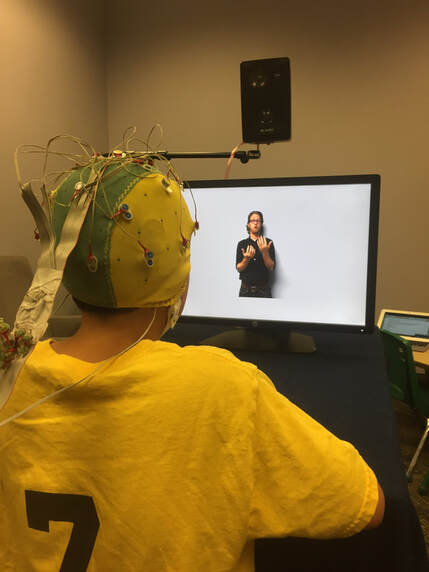What is a signed language?
Signed languages are spontaneously-arising natural languages used by Deaf people. Many different unrelated signed languages exist throughout the world–wherever there are communities of Deaf people, there is a signed language (Senghas, Kita, & Özyürek, 2004). The signed language used in the US and parts of Canada is known as American Sign Language (ASL).
Spoken languages may be the dominant communication system used throughout the world, but signed languages are not manual translations of spoken languages used by hearing people or simply conventionalized gestures. Rather, signed languages are autonomous languages that exhibit linguistically complex structures and are fully able to convey abstract concepts.
Each sign exhibits a complex hierarchical linguistic structure (Corina & Sandler, 1993).
William Stokoe’s ground breaking work in the 1960s launched the formal studies of ASL in the United States.
Sign Language Acquisition
All children come into the world ready to learn any language they are exposed to, spoken or signed (Krentz & Corina, 2008).
Deaf children born into a deaf family and exposed to a signed language from birth, acquire sign language at a developmental time course similar to that of hearing children natively acquiring a spoken language (Anderson & Reilly, 2002). They begin producing language at around 12 months and continue to develop in language processing efficiency over the first few years of life (MacDonald et al., submitted).
However, over 90% of deaf children are born to hearing parents who do not know a signed language. These deaf children often experience delayed exposure to a signed language. Such delayed exposure can lead to delayed acquisition and lasting deficits in language ability (Mayberry, 2010).
Cross Modal Priming
We are currently recruiting deaf and hearing children ages 2 yrs to 8 yrs who are exposed to American Sign language to participate in a study that uses American Sign language, primes paired with a picture that either matches or mismatches. Children do not need to respond, just watch. We also have a similar paradigm without sign language, where the primed word presented auditorily and paired with the same pictures, for children that are not familiar with ASL. The primary component that we will be observing in these experiments is the N400. The N400 component is a negative deflection that peaks around 400 msc, post stimulus and is associated with mismatch. We will compare the timing and amplitudes of this component across different populations, ages and modalities (visual vs. auditory).

